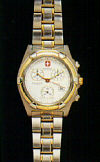It's Dec. 25, 1969, and the Japanese
company Seiko has a Christmas
gift for consumers everywhere. Sure, at $1,250, it's a little expensive. But consider this: It's accurate to within 5 seconds a day, and it never needs winding.
  |
Above, left: The first quartz movement, made in Switzerland in 1967
Above, right: A quartz crystal |

The world's first quartz watch-Seiko's quartz Astron 355Q |
Seiko's "Quartz Astron 35SQ," proudly unveiled that Christmas Day, was the shot heard round the watch world: the start of a watch industry shake-up that would topple its long-time leaders and crown new ones. For the consumer it would mean nothing but good news: Timekeeping was easier and more accurate than ever before.
At the center of the maelstrom was a tiny synthetic quartz crystal which, when charged with electric current, vibrated thousands of times faster- 32,768 times per second, to be exact-than the balance wheel in a mechanical timepiece. Faster oscillations mean greater accuracy, whether the oscillator in question is the pendulum on a grandfather's clock or a small piece of U-shaped quartz.
Although Seiko introduced the first quartz watch, the Swiss industry invented it. The Swiss completed the first quartz movement in 1967, the product of a cooperative effort among several companies. But they balked at putting the watch into production. Some believed quartz would prove to be a mere fad; others feared the cost of converting their factories would kill them. (They did eventually make the change, but too late to push the Japanese out of the spotlight.)
Five months after the Astron introduction, Pulsar, then owned by the U.S. firm Hamilton Watch Co., announced another horological surprise: a quartz watch that told the time with numbers rather than a dial and
hands. This watch, the world's first solid state digital model, showed the time by means of a light-emitting diode (LED, in industry parlance) that lit up the numbers when the wearer pushed a button. Due to technical problems, the watch did not make it to market until 1972. When it did, it was a hit despite its lordly $2, 100 price tag (or perhaps because of it-the watch was sold in posh jewelry stores such as Tiffany's and was a real status symbol). By 1972 more than 50 companies were selling LEDs in the U.S., at prices that dropped within a few years to a mere $20 or less.
  |
 Quartz watches from (clockwise from top left): Delma, Wittnauer, and Wenger Quartz watches from (clockwise from top left): Delma, Wittnauer, and Wenger |
The LED didn't last long. By the late '70s a new type of digital, the liquid crystal display (LCD), had taken over. Unlike the LED, the LCD told the time all the time, not just when the wearer pushed a button. LCDS, produced largely by a burgeoning Hong Kong watch industry, became plentiful and cheap, even cheaper than the LED.
The digital craze hit its peak in the mid-'80s when, worldwide, companies were turning out more quartz digital watches than they were quartz analog ones. The frenzy soon ended. A glut developed, prices continued to drop, and the glamour and mystique that had so attracted digital watch customers a decade before disappeared.
The trend toward quartz, however, got stronger by the minute. Analog quartz watches, which leant themselves much better than digitals to stylish design, ascended to a new status. Watch companies brought out a bevy of elegant quartz analog models, slimmer than watches had ever been thanks to the compactness of quartz movements. In 1979, Concord took skinny to the extreme when it launched the Delirium, just 1.98mm thick.
Furthermore, quartz, with its accompanying micro-circuitry, made it possible to provide an amazing array of functions- a chronograph, or stopwatch function; a lap timer, to store the different times it takes to run the laps in a race; a countdown timer, which keeps track of the time before a race begins; and many others. All were as accurate as anyone could want.







 Quartz watches from (clockwise from top left): Delma, Wittnauer, and Wenger
Quartz watches from (clockwise from top left): Delma, Wittnauer, and Wenger